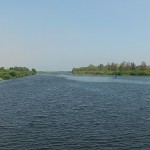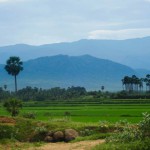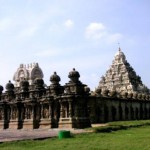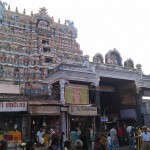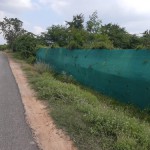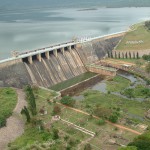Upgrade & Secure Your Future with DevOps, SRE, DevSecOps, MLOps!
We spend hours scrolling social media and waste money on things we forget, but won’t spend 30 minutes a day earning certifications that can change our lives.
Master in DevOps, SRE, DevSecOps & MLOps by DevOps School!
Learn from Guru Rajesh Kumar and double your salary in just one year.
| Thirunelveli Districts |
| About: |
| Tirunelveli District enjoys the benefit of the early showers of south west monsoon and of the later rains of the north-east monsoon. The district is chiefly irrigated by rivers rising in Western ghats. The dams and anaicuts constructed on Tamiraparani and Manimuthar rivers serve both agriculture and power generation. The total fall, though is light, averaging about 814.8 mm per annum, is generally well distributed. The Tamiraparani river affords perennial irrigation to a fairly large area on which two crops are normally raised. Several tanks and wells form part of the other source of irrigation.The district has peculiar climate and receives rainfall in all the seasons which represent 953.1 mm in 2005-2006. Tirunelveli District benefits from both the North East Monsoon and the South West Monsoon. The maximum precipitation is contributed by the North East Monsoon at 548.7 mm followed by the South West Monsoon at 147.8 mm and the Summer 184.2 mm. The district is irrigated by several rivers originating in Western Ghats, like the Pachaiyar River which soon mergers with the Tambaraparani River. The Tambaraparani River and the Manimuthar River both have many anicuts and dams with reservoirs that provide water for both agriculture irrigation and power generation. The Tamiraparani River provides consistent irrigation to a large agricultural area. [4] The Chittar River also originates in this district. Courtallam and Manimuthar Waterfalls are the two major waterfalls in the district.The Tamiraparani is a symbol of Tamil culture and civilization and an identity of the far south of India. In Tamil and Sanskrit literature of earlier times, the Pandyas were referred to as the rulers of the land where the Tamaraparani flowed. Tamiraparani is the chief river of the district which has a large network of tributaries which includes the Peyar, Ullar, Karaiyar, Servalar, Pampar, Manimuthar, Varahanathi, Ramanathi, Jambunathi, Gadananathi, Kallar, Karunaiyar, Pachaiyar, Chittar, Gundar,Aintharuviar, Hanumanathi, Karuppanathi and Aluthakanniar. The two rivers of the district which are not linked with Tamiraparani are the Nambiar and the Hanumanathi of Nanguneri taluk. (There are two Hanumanathis in the district).The glory of Tirunelveli District is the pride of Tamils. The crawling clouds on the Western Ghats, the picturesque Pothigai hills and the Courtallam water falls are the special features which make Tirunelveli unique. The city also goes by the name Nellai. The district is known for its paddy fields. The name ‘Tiru-Nel-Veli’ owes to a Hindu mythological story where Lord Shiva protected the paddy (‘nel’) by creating a fence (‘veli’).Tirunelveli District, the penultimate southern most district of Tamil Nadu, is described as a microcosm of the State. The district has diverse geographical and physical features such as lofty mountains and low plains, rivers and cascades, seacoast and thick inland forest, sandy soils and fertile alluvium, a variety of flora, fauna, and protected wild life. |
| The meaning and origin of the name Tamiraparani is reasoned out differently. Bishop R. Caldwell, in his book, A History of Tinnevelly discussed the various interpretations of the word ‘Tamiraparani’ at length. According to him the meaning of the name Tamiraparani in itself is sufficiently clear, but its application in this connection is far from being self-evident. Tamara means, red, parani means parana, a tree which has leaves. Tamiraparani might, therefore mean a tree with red leaves, but, this is a strange derivation for, the name of a river and the ideas naturally suggest itself that some events or legends capable of explaining the name lies beyond. He further discussed the similarity of the name Tamiraparani and of the old name of the present Sri Lanka which was called in olden days as Tambrabane and tried to find out the political, cultural and anthropological intercourse of the land of the river with that island. He concludes that it seems more natural that Tamiraparani, the tree with the red leaves should have been first the name of a tree, then of a town, then of a district and then of a river (it being not uncommon in India for villages to adopt their names from remarkable trees).Mundanthurai Tiger Reserve Wild Life sanctuaries, District Science Centre, Tirunelveli, Birds Sanctuary at Koonthankulam, Courtallam Health Resort, Krishnapuram Sculptures, Pulithevan Palace , Swamy Nellaiappar Temple & Kanthimathi Ambal Temple, Sankaranainarkoil, Manjolai – Hill Station, Kappal Matha Church, Uvari, Pottalpudur Dargha , Thiruvalluvar Two Tier Bridge, Holy Trinity Cathedral (Oosi Gopuram). |
| Location info: |
| Tirunelveli District,Tamil Nadu,India |
| Climate/Weather of Thirunelveli Districts: |
| Temperature: The average maximum temperature for the district (from 1991 to 1996)as a whole is about 32.460 C and the average minimum temperature is 24.750C. |
| History of Thirunelveli Districts: |
| Tirunelveli District was formed on September 1, 1790 (Tirunelveli Day) by the East India Company (British) and named it as Tinnevelly district though their headquarters was first located in Palayamkottai the adjacent city, where they had their military headquarters during their operations against the Palayakars. There are three reasons attributed for naming the district after Tirunelveli. The prime one is that it has been serving as the main city of the district and the second one is that it has been called called as Tirunelveli Seemai under the Nayaks and Nawabs. Finally it served as the south capital in the period of Pandyan Kingdom. Both Tirunelveli and Palayamkottai grew as the twin cities of the district. |
| Educational Institutions of Thirunelveli Districts: |
| Arts & Science: Govt. Arts College for Women, Tirunelveli Ambai Arts College, Tirunelveli Annai Hajira Women’s College, Melapalayam C.S.I. Jeyaraj Annapackiam College, Tirunelveli Pasumbon Muthuramalinga Thevar College, Melaneelithanallur, Tirunelveli Perarignar Anna College, Tirunelveli Rose Mary Arts and Science College, Palayamkottai Sadakathullah Appa College, Palayamkottai Sarah Tucker College, Palayamkottai Sardar Raja Arts College, Tirunelveli Sattanatha Karaiyalar College, Tenkasi Sri Paramakalyani College, Tirunelveli Sri Parasakthi Women’s College, Tirunelveli Sri Saradha Women’s College, Tirunelveli St. John’s College, Tirunelveli, Palayamkottai St. Xavier’s College, Tirunelveli T.D.M.N.S. College, T. Kallikulam, Tirunelveli The M.D.T. Hindu College, Tirunelveli Thiruvalluvar College, TirunelveliHotel Management: Nellai Institute of Hotel Management, Tirunelveli Rajiv Gandhi Institute of Hotel Management and Catering Technology, Tenkasi Rass Academy College of Hotel Management and Catering Technology, Palayamkottai Sarah Tucker College, PalayamkottaiDental: Rajas Dental College, VadakangulamEngineering: PET Engineering College, Vallioor Govt. College of Engineering, Tirunelveli Cape Institute of Technology, Radhapuram Taluk Einstein College of Engineering, Tirunelveli Taluk Francis Xavier Engineering College, Palayamkottai J.P. College of Engineering, Ayikudy Tenkasi Taluk Joe Suresh Engineering College, Tirunelveli Mahakavi Bharathiyar College of Engineering and Technology, Sivagiri Taluk National College of Engineering, Nanguneri Taluk P.S.N. College of Engineering and Technology, Palayamkottai Taluk P.S.N. Engineering College, Palayamkottai S. Veerasamy Chettiar College of Engineering and Technology, Sivagiri Taluk SCAD College of Engineering, Ambasamudram The Rajaas Engineering College, VadakkangulamMedical: Tirunelveli Medical College, Tirunelveli |
| Langauge |
| Three languages namely Tamil, Telugu and Kannada are predominantly spoken in this district. |
| Culture: |
| Tamil Nadu finds a prime position on the cultural map of the country. The state’s contribution to literature, music, arts of Indian classical culture is praiseworthy. Dance, music, art and crafts and celebration of various festivals form important parts of Tamil culture. The various fairs and festivals are celebrated with great enthusiasm. Tamil people have their own living style which is reflected in their food, costumes, language and folk art and culture. Let’s find more about thecultural heritages of the state..Mango Festival:Krishnagiri is the venue for this famous festival, celebrated on the last 3 days of June. An event for the buyers and sellers to meet, various mangoes are kept on display at this festival.Car festival:Held in the month of May every year at nearby Denkanikottai, this popular festival is thronged by hordes of devotees. |
| How to reach? |
| Nearest Railway Station:Tirunelveli is an important railway junction on the southern railway and is connected to all major cities. |
| Nearest Airport:Madurai, 151 Kms away. |
| Road Transport:Tirunelveli is served by a good network of roads. |
| Tourist Attraction of Thirunelveli Districts: |
| Koothankulam Bird Sanctuary: Koothankulam Bird Sanctuary, at a tiny village situated 35 km away from the Tirunelveli city in the far south of Tirunelveli district is emerging as a new favorite spot for migratory birds. The village is sparsely populated. Migratory birds arrive here in the month of December end and lay eggs. After hatching and growing the newborns, it flies back in the month of July to its destination with the younger ones. The bird observers found around 35 species of birds in this sanctuary. Some Painted Storks come from East European countries. To create a friendly environment to migratory birds, the state government makes plenty of activities.Sivasailam: Sivasailam is a small Temple named after Sivasailappar and Paramakalyani amman Parvathi. This temple is situated on the banks of the river Karunai, on the way of Ambai to Thenkasi.Manimuthar Waterfalls: Manimuthar Falls is a natural water falls flowing through out the year situated above the Manimuthar dam. Really it is an adventurous feeling, if people drive there by bike. The falls near by has a pond which has a depth of 90 feet. It is really a picturesque place. It is just in 35 km from Tirunelveli city. There is no public transport service to go this place. The private cabs are offering the service from Tirunelveli. Tenkasi: The name itself implies that this town is ‘Kasi Varanasi of the South’. The flag staff of the temple is noteworthy for its sculptural beauty and is 400 years old. Tenkasi is also the nearest place to Courtrallam just 6 km away, which is well known for its waterfalls. The water of these falls is considered to cure several diseases owing to the different herbs on its path.Ambasamudram: A small town in the foothills of Western Ghats is one of the five taluk headquarters of the district. Ambasamudram serves as the main transit point for Papanasam, Manimuthar, Courtallam and for Sabarimala devotees going through Shengottai. Situated in the banks of the perennial river Tamirabarani, it is one of the most pristine and fertile towns of the district. The town is famous for its Wooden Handicrafts Kadasal. There is not much industrial presence in the town except for an ailing Madura Coats. There is a famous temple named Agasthiyar Kovil and it was named because of some true incidents. Deivacheyalpuram: Deivacheyalpuram is a small village situated at 21 km from Tirunelveli enroute to Thoothukudi. The Rajarajeswari temple and the Ramar temple are situated here. Also a 75 foot statue of Lord Anjaneya constructed in the temple premises, to attain world peace, is here. Poojas are performed in these temples everyday with special poojas performed every Fridays and on festivals. On every full moon day, the temple conducts Annadanam. Manapad: The Holy Cross Church at Manapad was built in 1581. Thousands of worshippers congregate during the festival season from 1 to 14 September every year. The church is associated with St. Francis Xavier. Puliangudi: A bustling town between Rajapalayam and Tenkasi.Also known as Lemon City due to contribution of Lemon to its economy in the past.Koottapuly: The coastal border village in Tirunelveli district has the very first St. Joseph’s church in south India and one of the oldest St.Joseph’s church in the globe,In 2007 people of Koottapuly has celebrated 150 years for this church. St.Xavier was stayed for few days in this village during his India visit in 16th century .Kootapuli village is a coastal village. It is situated the north side of Indian ocean. Kootapuli village is around 40 kilometers from Nagercoil City. 75 Kilometers from Tirunelveli District. Kootapuly village is in edge of the Tamilnadu.Almost 75% of people in this village are educated people. The main occupation and source of income here is fishing (75%). The whole population of Kootapuli belongs to one caste and one religion. The caste is Paravar and the religion is Roman Catholics. People have migrated to different parts of coastal India and Sri Lanka. They have a rich culture before converting to Christianity as well as after conversion.Paravas were the first whole community in India to convert to Christianity in the mid-16th century. St. Francis Xavier who had travelled through out the southern costal region of India, who had converted the Paravars to Christianity. Krishnapuram: The temple in Krishnapuram is dedicated to Lord Vishnu. The presiding deity is Thiruvenkatanathar. There are a number of life-size sculptures in this temple with intricate workmanship. Vallioor: Valliyur or Vallioor is a panchayat union in Radhapuram taluk in Tirunelveli district in the Indian state of Tamil Nadu.Valliyur is one of the fastest growing towns in Tirunelveli district. This town is located along NH7. It gets its name from the goddess Valli, consort of Lord Murugan.Its in a place that connecting two big towns as Tirunelveli and Nagercoil in NH7Once a shanty village with farmers and shepherds, The people of Valliyoor are known for their business acumen and high standard of education. The beautiful Murugan Temple, the oceanic Valliyoor Kulam, the wide and appeasing Kuravan MalaiWestern Ghats gives the town a beautiful look and feel. Valliyoor today has good Kalyanamandapams, bus station, beautiful churches, old temples of architectural importance, schools of international standards, fire stations, vibrant transport system and much The recent addition to Valliyur is the United Volunteer Service Society UVSS New Life Home for Aged Destitutes. Located about 7 km towards Eruvadi. This is a new initiative by like minded people and does not involve any specific religious group or Government or specific community.Tiger Reserve: The 900 km² Kalakkad Mundanthurai Tiger Reserve was established in 1962. Central location: 8°39′N 77°23′E / 8.65°N 77.383°E / 8.65; 77.383 is about 45 km west from Tirunelveli Town.Koovachipatti: Hi iam jothiraj.This is my village.Aroundly 300 families living in my village.In my village IRULAPPASWAMY Temple is one of the famous temple in village.Many more peoples will coming every tuesday and friday’s from all places in Tamilnadu.Every year tamil month panguni second friday my village people celebrate this temple.Minimum 3000 peoples attend the function.Tirunelveli: One of the famous temples in Tamilnadu is located at Tirunelveli. The Nellaiappar Temple is deeply connected with tradition and history and also known for its musical pillars and other splendid sculptured figures.The nearest airport is Tuticorin Airport TCR at Vagaikulam in 30 minutes drive, which is 28 km from Tirunelveli. Train route is available from chennai, madurai Nanguneri: The temple town of Nanguneri is situated 31 km south of Thirunelvei famous for the large Vishnu temple. The prime deity in the temple is Thotathri Nathan. The temple is run by the Vanamamalai mutt and houses the famous Ennai Kenaru oil wel.Sankarankovil: This temple depicts the concept of Hari and Haran being one God. There is a deity by the name Sankara Narayanan, which is half Lord Shiva and the other half Lord Vishnu. Also, there is another deity, named Avodai ambal or Gomathi Ambal. There is a sacred sand available in Gomathi Ambal temple, which is believed to cure the diseases. There is a famous festival Adi Thabasu in the month of June which is observed in this temple. Another one history is in that temple, this temple was built by Ukerama Pandiyan in 900 AD.Chilly commission mondey is famous in this place. Largest Textile manufacturing unit is the Second place in Tamil NaduCSI Church: It is a village which is situated near Nanguneri. Rev. C.T.E. Rhenius is the Father of Dohnavur. He purchased lands and constructed the big Church (CSI Christ Church) with the help of Prussian gentleman, Count Dohna and named the village as “Dohnavur”. Rev. Thomas Walker constructed a school Walker Hr. Sec. School in Dohnavur and Mother Amy Carmichael constructed a Hospital Parama Sugasalai and started an Orphanage.Geographically the village is surrounded by Ponds. Most of the people who lives in Dohnavur are farmers and Building Contractors. You can see many Teachers in Dohnavur. The Holy Land is blessed by Lord Jesus Christ Maruthur: An untapped tourist pottantial of this district.This village situated 12Km from Palayamkottai. The stone made dam otherwise called as anaikattu is the beauty of this village. This anaikattu was constructed during the pandia kingdom. The British government repaired the dam on 1872. The dam is across the river Thamirabarani. The dam is with a height of 20-35 feet & with a length of 2.5 km. The engineering marvel of the dam is tht it was construted in concave shape across the river & the cutting edges of tope stones also in concave shape to facilitate easy flow of water. The dam splits thamirabarini river water in to maruthur melakal[western channel], maruthur kelakal[eastern channel]. Just walking on the stone wall by seeing the water flow on both side is an amazing experence.Taking bath in eastrn side of stone wall also gives you a natural touch.Parappadi: This village have more than 7000 population. it have one of the largest church Holy trinity Church for christians & One temple Mutharamman Kovil for Hindus. village situated 11 km east of Nanguneri.Veeravanallur: This village has more population than the taluk Ambasamudram. It has Electrical Power Substation, Gomathi Mills and Power weaving mill. Hand loom weaver’s are mostly from sorastrian & mudaliyar caste. Surrounding villages are Harikesavanallur, Kiriyammalpuram, Manabaranallur, Nainar colony, Thambran colony, Parayadi pacheri, Retiyarpuram, Malayangulam, Vellangulli & Puthukudi.Perumal Nagar: Village situated 5 km in east of Nanguneri.Pappankulam: Village situated 15 km in east of Nanguneri and famous of Mutharamman Temple.Othere Places:Main Falls Small Falls Five Falls VIP Falls Tiger Falls Old Courtallam Falls SenbahaDevi Falls Honey Falls |
| Hotels/Lodge/Accommodation in Thirunelveli Districts: |
| Hotel Nainaar:Tirunelveli, Tamil NaduSri Bharani Hotel:Tirunelveli, Tamil NaduSakuntala Hotel:Tirunelveli, Tamil NaduAnnapoorna Hotel:Thirunelveli,Tamil NaduHotel Jony:Thoothukudi,Tamil Nad,Ph:04652 2328350Hotel Parvathy Residency:400, P.W.D Road, Nagercoil, Kanyakumari, Tamil Nadu Indi,Ph:04652 227799 |
| Links: |
| http://www.collegesintamilnadu.com/Tamil-Nadu-Districts/Tirunelveli-Colleges.asphttp://www.nellai.tn.nic.in/irrigation.html |
